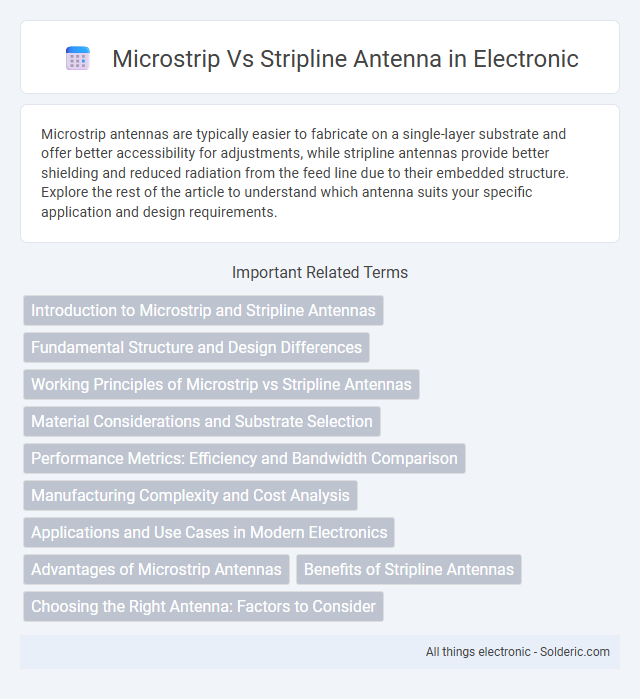Microstrip antennas are typically easier to fabricate on a single-layer substrate and offer better accessibility for adjustments, while stripline antennas provide better shielding and reduced radiation from the feed line due to their embedded structure. Explore the rest of the article to understand which antenna suits your specific application and design requirements.
Comparison Table
| Feature | Microstrip Antenna | Stripline Antenna |
|---|---|---|
| Structure | Conductive patch on a dielectric substrate with a ground plane underneath | Conductor sandwiched between two dielectric substrates with ground planes on both sides |
| Radiation Pattern | Broadside radiation with moderate gain | Confined radiation, lower external radiation |
| Bandwidth | Typically narrow (1-5%) | Very narrow bandwidth |
| Size | Compact and planar | Compact but more complex due to multilayer structure |
| Polarization | Supports linear and circular polarization | Primarily linear polarization |
| Manufacturing Complexity | Simple and cost-effective | More complex, costly due to multilayer assembly |
| Losses | Moderate dielectric and conductor losses | Lower losses due to better shielding |
| Applications | Wi-Fi, GPS, mobile devices, RFID | High-frequency, radar, and military communication systems |
Introduction to Microstrip and Stripline Antennas
Microstrip antennas consist of a metallic patch on a dielectric substrate above a ground plane, offering a low-profile, lightweight solution ideal for wireless communication. Stripline antennas feature a conductor embedded between two ground planes within a dielectric, providing superior isolation and reduced radiation leakage. Your choice between microstrip and stripline antennas depends on factors like bandwidth, size constraints, and environmental interference.
Fundamental Structure and Design Differences
Microstrip antennas consist of a radiating patch on one side of a dielectric substrate with a ground plane on the opposite side, while stripline antennas have the conductor sandwiched between two ground planes within the substrate. The microstrip's open structure results in easier fabrication and integration with circuits but increased radiation loss, whereas stripline's enclosed design offers better shielding and reduced interference at the cost of more complex manufacturing. Your choice depends on trade-offs between ease of fabrication, radiation efficiency, and environmental isolation needs.
Working Principles of Microstrip vs Stripline Antennas
Microstrip antennas operate by radiating electromagnetic waves from a patch conductor placed above a ground plane with a dielectric substrate in between, enabling surface current flow that generates radiation primarily in the fringing fields around the patch edges. Stripline antennas function by confining electromagnetic waves between two parallel ground planes with the strip conductor sandwiched in the dielectric, which reduces radiation losses and provides better shielding but limits radiation primarily through slots or apertures. Your choice depends on whether efficient radiation with minimal structure (microstrip) or controlled, low-loss transmission with isolation (stripline) aligns better with your design requirements.
Material Considerations and Substrate Selection
Microstrip antennas typically use low-loss dielectric materials like Rogers RO4003C or FR4 substrates to optimize signal integrity and minimize dielectric losses. Stripline antennas require substrates with consistent permittivity and low dielectric constant to ensure proper confinement of the electromagnetic field between ground planes, often favoring materials such as PTFE or ceramic-filled laminates. Selecting the right substrate material directly influences your antenna's efficiency, bandwidth, and overall performance in high-frequency applications.
Performance Metrics: Efficiency and Bandwidth Comparison
Microstrip antennas typically offer moderate efficiency due to dielectric and conductor losses but provide wider bandwidth through techniques like substrate modification and impedance matching. Stripline antennas exhibit higher efficiency because of their enclosed structure reducing radiation losses but generally have narrower bandwidth limited by their multilayer configuration. Bandwidth enhancement in stripline designs requires complex multilayer tuning, whereas microstrip antennas achieve broader bandwidth with simpler fabrication and substrate optimization.
Manufacturing Complexity and Cost Analysis
Microstrip antennas typically feature simpler manufacturing processes due to their single-layer PCB design, resulting in lower production costs and easier mass fabrication compared to stripline antennas. Stripline antennas require multi-layer PCB construction and precise alignment of internal conductors, increasing manufacturing complexity and costs significantly. The additional fabrication steps and materials needed for stripline configurations make them less cost-effective for large-scale production compared to microstrip antennas.
Applications and Use Cases in Modern Electronics
Microstrip antennas are widely used in mobile devices, satellite communications, and wireless networking due to their low profile, ease of fabrication, and integration with printed circuit boards. Stripline antennas offer better electromagnetic shielding and reduced interference, making them ideal for aerospace, military, and high-frequency instrumentation applications. Your choice between microstrip and stripline antennas depends on the balance between compactness and signal integrity required in your specific electronic system.
Advantages of Microstrip Antennas
Microstrip antennas offer advantages such as low profile, lightweight structure, and ease of integration with microwave circuits, making them ideal for compact and portable applications. Their planar configuration allows for simple fabrication using printed circuit technology, enabling cost-effective mass production and conformal mounting on surfaces. High versatility in design supports wide bandwidth and multi-frequency operation, enhancing overall system performance in wireless communication devices.
Benefits of Stripline Antennas
Stripline antennas offer superior electromagnetic shielding and reduced interference compared to microstrip antennas due to their embedded structure between ground planes. This results in improved signal integrity and consistent radiation patterns, making them ideal for applications requiring high reliability and low noise. Your communication systems benefit from the stripline's enhanced isolation and stability in densely packed electronic environments.
Choosing the Right Antenna: Factors to Consider
Microstrip antennas offer ease of fabrication and low profile, ideal for compact, planar devices, while stripline antennas provide superior shielding and reduced electromagnetic interference, making them suitable for high-frequency, noise-sensitive applications. When choosing the right antenna for your design, consider factors such as operating frequency, bandwidth requirements, radiation pattern, and environmental conditions. Your antenna selection should balance performance needs with integration constraints to ensure optimal signal quality and device functionality.
microstrip vs stripline antenna Infographic

 solderic.com
solderic.com